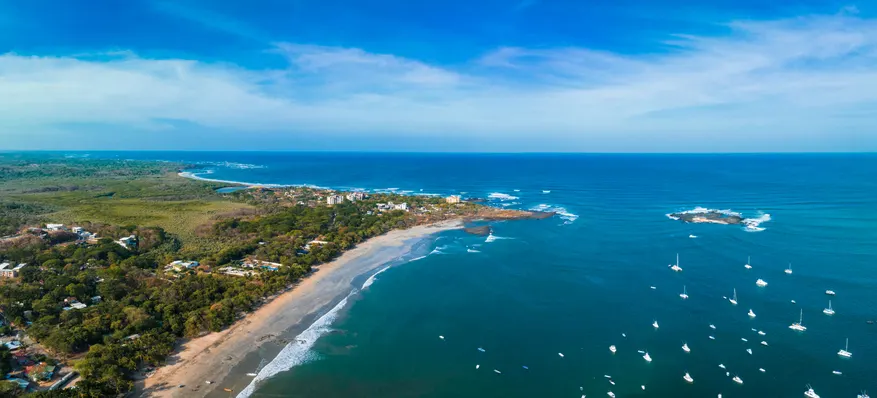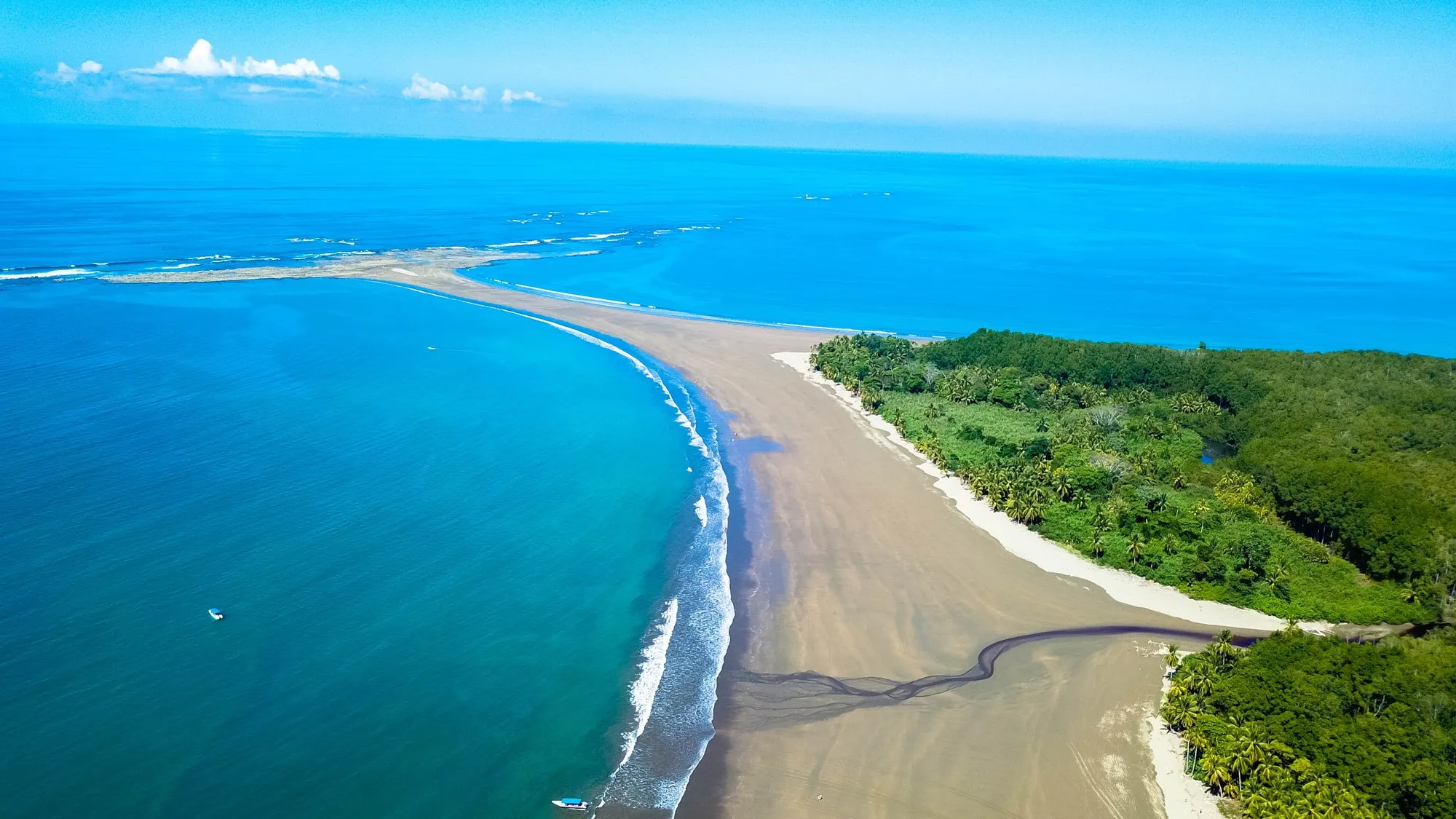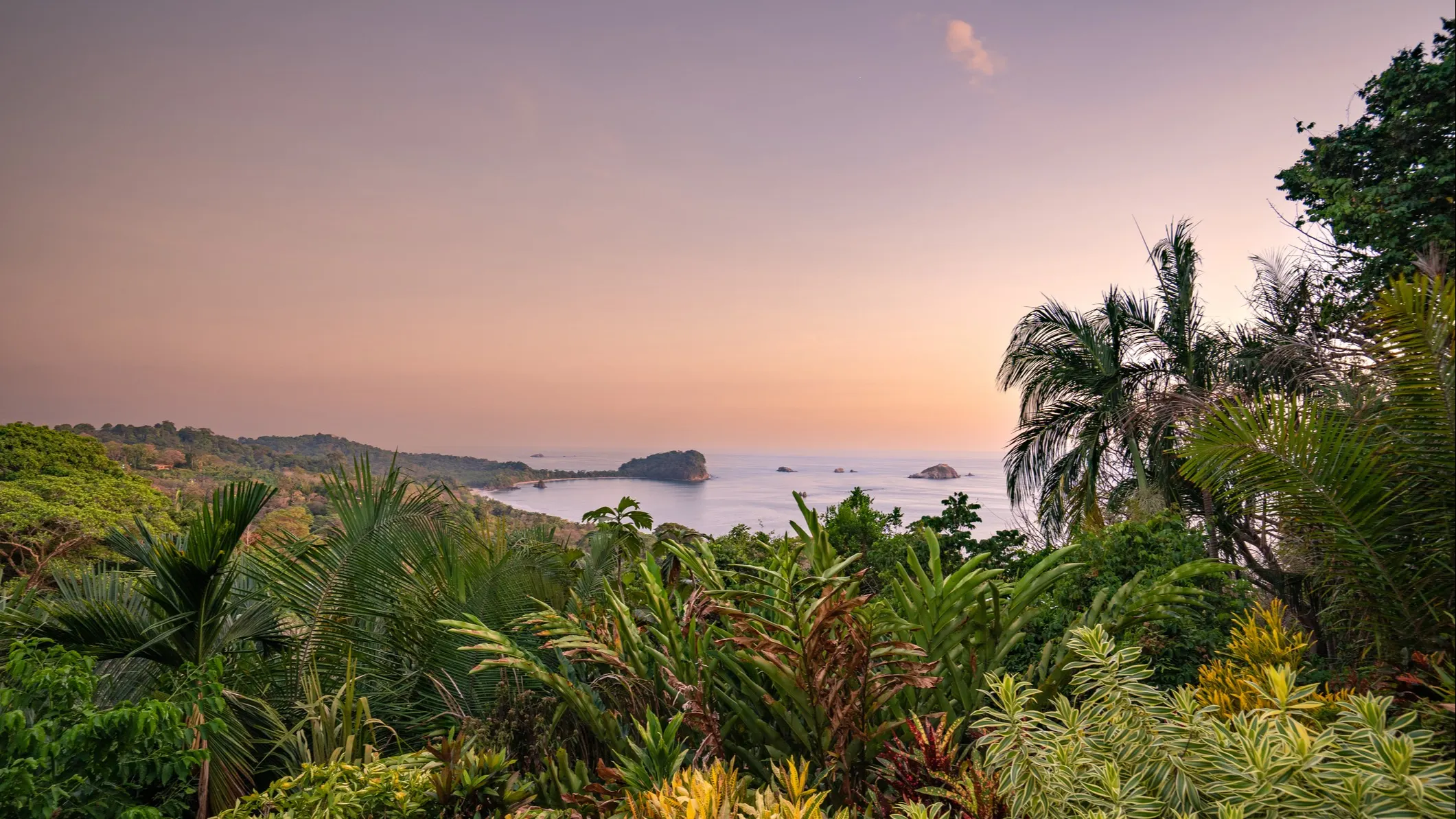In a country with a population of just over 5.2 million people, it speaks volumes of its desirability, that an estimated half a million of them (10%) are expats/immigrants. Year after year, this tropical gem continues to be the shining star of Central America.
A beacon of stability in an oft-unstable region, Costa Rica offers a lifestyle many dreams of. Palm trees sway in the warm breezes while northern neighbors are digging out of snow. A stable democracy where the military was abolished over six decades ago. A place where healthy options abound, from natural food to outdoor activities to affordable healthcare.
Get Your Free Costa Rica Report Here
Get Your Free Costa Rica Report Here
Learn more about Costa Rica and other countries in our daily postcard e-letter. Simply enter your email address below and we’ll send you a FREE REPORT - Explore the Old World in Laidback Costa Rica.

By submitting your email address, you will receive a free subscription to IL Postcards, Overseas Dream Home, The Untourist Daily and special offers from International Living and our affiliates. You can unsubscribe at any time, and we encourage you to read more about our Privacy Policy.
This article covers five popular expat towns in different regions of the country. There is practically no corner of habitable Costa Rica that is not touched by the influence of expats from around the world. So, it is impossible to cover every popular town. However, there are some things that all these places share. There is a network of English-speaking expats (as well as plenty of locals) to help you integrate into a new life in Costa Rica.
All these towns and nearby areas also have internet options to keep you connected and enough shopping, minor healthcare clinics, pharmacies, banks, restaurants, and activities to cover you in your day-to-day living. Plus, they are all serviced by a regional or major airport less than an hour’s drive. Lastly, all these towns would be considered a safe place to bring your family.
Rohrmoser, Pavas, San José

Over 1/3 of Costa Rica’s population lives within the GAM (greater metropolitan area) of the capital San José. So, it is no surprise that you will find everything you need within a short drive or walk. At first visit, San José can appear to be a rambling chaotic city lacking in the natural beauty associated with the picture-perfect tourism board promotional material.
But when you break it down into neighborhoods, you quickly learn which areas are worthy places to call home and which you should avoid. Rohrmoser, with its year-round temperate weather (no need for air conditioning or heat) and nearby amenities, is one of those you should shortlist if you like city life. It is home to the former president and Nobel Peace Prize winner Oscar Arias.
In the 1960s, the Rohrmoser family developed the coffee fields on the west side of San José. It is considered one of the first master-planned subdivisions in San José. The mature tree-lined streets (all with sidewalks) and upscale homes set on large lots with courtyards add a certain charm to the neighborhood. It is a walkable neighborhood with shops, restaurants, clinics, pharmacies, banks, and plenty of street parking – with two main boulevards for access and located on bus routes if you don’t have a car.
You will see people daily walking their dogs, jogging, playing sports, and enjoying a family picnic in nearby La Sabana Park—a glorious 153-acre green space just west of the old downtown area with hiking and biking trails. Within the park is the Costa Rican National Stadium, with towering metal installations reminiscent of the Sydney Opera House. The multi-use stadium houses fútbol (soccer) games, as well as big-name concerts.
This area offers housing at prices more affordable than you will find in the popular beach areas, especially along the Gold Coast in Guanacaste. Several new, modern condo towers exist or are in the development stages—with North American-style amenities (garage parking, rooftop pool, hot tub, gym, pool tables, party room, library, etc.) with two-bedroom condos for sale in the low $200,000’s and monthly rentals in the $1,200 range. The city views are incredible with all the sparkling lights and the mountainous backdrop.
This location is less than 30 minutes to Juan Santamaria International Airport, mega shopping for all the big brand names in close-by Escazú, international schools, and the best medical centers and hospitals in the country (CIMA, Clínica Bíblica, Hospital La Católica, and the public facility Hospital México). The US Embassy is just five minutes away. Plus, you have easy access to the tollway west if you are looking for a beach escape. It is less than two hours to Jaco on the Central Coast.
Playa Flamingo

If you like buckets of sunshine, this is the best place for you to be in Costa Rica—in the northwest corner of the country on the Pacific Ocean in the Guanacaste province. It’s consistently warm to hot 92 F for a high and rarely gets below 78 F at the coldest - and sunny much of the year. Even the “rainy” season has plenty of hours of sunshine.
With its closer proximity to the provincial capital of Liberia, expats in Flamingo enjoy the beach life but reside within a couple of hours of government offices for immigration and driver’s licenses, private and public hospitals, big box stores, car dealerships, and everything necessary to live in the country. Eliminating the stressful five-hour drive to San José.
It is no secret that the new marina in Flamingo has sent new waves of development and higher demand from expats. The Marina (opened in 2023) offers 92 wet slips with plans to expand to 184). The facilities in Flamingo Marina Village include upscale shops, restaurants and plans for an immigration office and a hotel. Giving a glimpse into the future of Flamingo added to the list of small cruise ports.
This area of Guanacaste is nicknamed the “Gold Coast” and has exploded in development over the last few years as more flights continually arrive at Daniel Oduber Quirós International Airport (Guanacaste airport code LIR). In fact, the airport has announced plans to build a private jet terminal.
Flamingo has no real town center, and the land behind its breathtaking white sand beach is protected from development because of a large mangrove forest (for now). Either hilly end of this beach has been constructed with condos, hotels, vacation rentals, shops, and restaurants. The central area remains a pristine beach. On the northern corner of town, the marina is situated behind a rocky point.
Although real estate has gone through the roof (you will be hard-pressed to find a two-bedroom home listed under $400,00) in Playa Flamingo, Brasilito to the south and Playa Potrero to the north offer some respite on real estate pricing. It is still possible to live within minutes of the marina scene without the high cost.
There are condos available at varying price ranges (occasional ones listed in the $200,000 range) and homes walkable to the beach (in the $300,000 range). Furnished rentals are in the range of $1300 to $2500/month.
The Brasilito-Flamingo-Potrero area also offers plenty to do, with many restaurants and bars to choose from and beautiful beaches. There are grocery stores, clinics, banks, and pharmacies. One of the best grocery store chains in the country, Auto Mercado, has announced plans to open a store in Flamingo. This is where you can find many popular North American grocery items. This area also has the best concentration of private schools, including CRIA (Costa Rica International Academy) and La Paz. Therefore, you will find many families with children in the area.
Like every city on this list, the expat community here is active and welcoming. Art classes, pickleball, water aerobics, yoga, golf—you do not have to look far to find something to keep you occupied. It is a touristy beach town in some ways, but Flamingo has a more sophisticated atmosphere without the hard-partying late-night crowd.
This area experiences drought, which can strain water availability. So, it is imperative to be sure your condo complex or home has a water tank to supply water for several days or that your property has a well.
Get Your Free Costa Rica Report Here
Get Your Free Costa Rica Report Here
Learn more about Costa Rica and other countries in our daily postcard e-letter. Simply enter your email address below and we’ll send you a FREE REPORT - Explore the Old World in Laidback Costa Rica.

By submitting your email address, you will receive a free subscription to IL Postcards, Overseas Dream Home, The Untourist Daily and special offers from International Living and our affiliates. You can unsubscribe at any time, and we encourage you to read more about our Privacy Policy.
Uvita

Uvita is the main town in the Southern Zone’s Costa Ballena (Whale Coast). It is situated between Dominical to the north and Ojochal to the south. People are drawn to this part of the country because it stays eternally verdant green throughout the year. It is the kind of place you conjure up in your mind when you see Costa Rica vacation brochures.
Mountainous rainforest teeming with nature juxtaposed against deserted beaches—waves crashing, parrots flying, monkeys chattering. Here you will not see the towering condos and fast-food joints. Although growing in popularity over the last decade, this area is still considered a fantastic region to decompress and get “off the grid.”
You can find “affordable” housing in the area with two-bedroom homes in the $200,000 to $399,000 range, and more expensive ones from $1 million+ in the hills, with sweeping views of the Pacific. You will also find the major grocery stores, as well as banks, restaurants, small medical centers, and all the basics you will need. It is just a short 15 to 20-minute drive to Dominical (a great surfer scene) or to Ojochal (a happening food scene).
For other government offices, car inspections, hospitals, and larger box stores, just an hour’s drive up the mountains to San Isidro de El General will cover what you need. This part of the country does experience more rain than most other places. But it is a welcomed trade-off to have the best biodiversity, plus there are no concerns about drought—something that Guanacaste can experience in dry season.
Quepos/Manuel Antonio

Quepos and Manuel Antonio are sister cities located on Costa Rica's Central Coast. This part of the country is breathtaking, and there is a good reason why expats are drawn here.
Quepos is home to a world-class marina, Pez Vela, in one of the most spectacular settings in the world. It offers 195 wet slips accommodating vessels up to 200 feet, as well as dry docks. With all the international amenities, this area attracts anglers, deep-sea competitors, and seafaring yachts from around the world. Quepos is a family-friendly community, with warm weather year-round (leave your coats at home) and a variety of housing, from basic to mansions. Although prices on the coasts have skyrocketed in the last few years, in Quepos, you can still find a two-bedroom home or condo in the low $200,000 range and furnished rentals for $1,100 or less once you get to know the market and network.
Down the road, around two-and-a-half miles is Manuel Antonio, home to the most visited national park of the same name. Like all the national parks, the biodiversity is breathtaking. Here you will find some of the country’s prettiest, pristine white-sand beaches and stunning landscape. As you drive from the higher elevation to sea level, the main road into downtown twists and turns with eye-popping scenic glimpses of the ocean. It is home to the largest LGBTQ+ community outside of the San José area. If you are looking for an alternative lifestyle with gay-friendly activities, Manuel Antonio is worth consideration. Manuel Antonio also has a vibrant arts community and a variety of restaurants. You are most likely not going to find any “steals” when it comes to real estate, though. Due to popularity, real estate prices have increased significantly over the past decade.
The two cities are about two and a half to three hours from the capital, San José, where you will find major medical care, government offices, malls, etc. However, this area is well equipped to cater to day-to-day living and has a regional airport in Quepos.
Nuevo Arenal

The popular town of Nuevo Arenal sits on the northern edge of 33-square-mile Lake Arenal and offers picture-perfect views of conical Arenal Volcano. Considered an optimal cooler temperature, compared to the beach towns, (you will rarely need air conditioning or heat) expats have been discovering the appeal of this area for decades.
Compared to any of the other places on this list, Nuevo Arenal is probably considered the smallest and most rural. But it is not isolated. Your day-to-day living amenities are right in town, from gas stations, shopping, pharmacies, banks, etc. And because the area around Arenal Volcano is such a popular tourist attraction, you have no shortage of restaurants all along the road on the north side of the lake—ranging from high-end cuisine to local sodas (small family-owned restaurants serving local Costa Rican cuisine).
Here, you are not going to find large-scale development like you will in some of the other communities around the country. Many of the homes have lake access or at least lake views. Ranging from $250,000 and up. Many even have a boat slip available—popular for anglers or those enjoying water activities. The lake is never busy, allowing a special calm you will not find with coastal waters.
If you enjoy keeping active, there are endless outdoor activities in the area. In and around Arenal National Park, you can enjoy everything from zip-lining, horseback riding, hiking, and whitewater rafting. Many of the streams around the volcano are heated geothermally by the volcano. Hotels offer day passes to enjoy their pools, waterfalls, and hot tubs. The locals know where to find these beautiful hot springs where you can lounge in the rapids and enjoy the geothermal waters for free — healthy for the mind, body, and soul.
This is country living at its best. But if you are the kind of person who likes big city activity you might find it a little bit too quiet here. However, the expats who live in and around Lake Arenal, enjoy that area because they are one with nature and prefer the peace.
As far as major medical care, you’re not going to find it right here. There are some small clinics in the area, and there is a town just near the lake called Tilarán, where you can find some larger medical centers. But if there are any major health issues, you would have to make the trek to Liberia (one-and-a-half hours) or San José (three-and-a-half hours).
Get Your Free Costa Rica Report Here
Get Your Free Costa Rica Report Here
Learn more about Costa Rica and other countries in our daily postcard e-letter. Simply enter your email address below and we’ll send you a FREE REPORT - Explore the Old World in Laidback Costa Rica.

By submitting your email address, you will receive a free subscription to IL Postcards, Overseas Dream Home, The Untourist Daily and special offers from International Living and our affiliates. You can unsubscribe at any time, and we encourage you to read more about our Privacy Policy.
